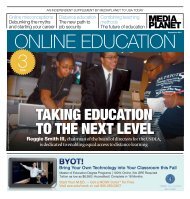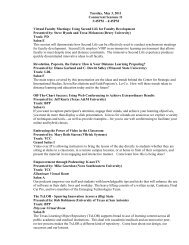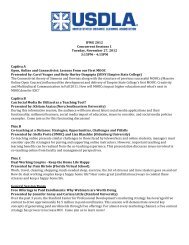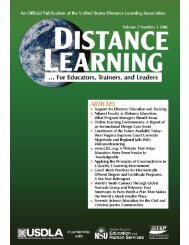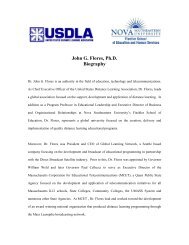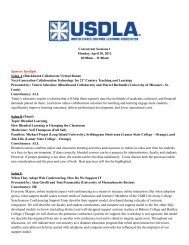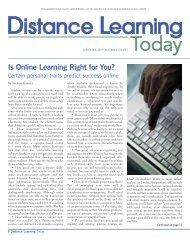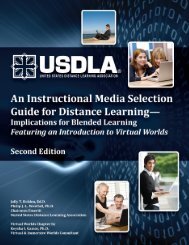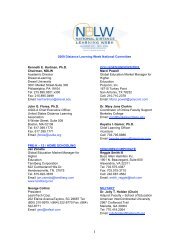United States Distance Learning Association
United States Distance Learning Association
United States Distance Learning Association
- No tags were found...
You also want an ePaper? Increase the reach of your titles
YUMPU automatically turns print PDFs into web optimized ePapers that Google loves.
Wimba Live Classroom<br />
A Case Study of Diffusion of Innovation<br />
Christina Rogoza<br />
Christina Rogoza, Instructional Designer,<br />
University of Manitoba,<br />
Extended Education Division.<br />
Telephone: (204) 474-8705.<br />
E-mail: rogoza@cc.umanitoba.ca<br />
The learning landscape is continuously<br />
changing and is reflected in<br />
the increase of online delivery of<br />
curriculum. In higher education, overall<br />
online enrollment increased from 1.98 million<br />
in 2003 to 3.1 million in 2006 representing<br />
a 64% increase in online engagement<br />
(Sloan Consortium, 2006). This no longer<br />
represents a trend but rather a process of<br />
diffusion of online learning as it becomes<br />
mainstreamed in higher education.<br />
Contrary to what we may assume about<br />
learners’ preferences for the online world,<br />
studies have shown that students prefer<br />
face-to-face environments for learning.<br />
The level of peer interaction and facultystudent<br />
interaction are important to students<br />
and contribute to overall student satisfaction<br />
with their learning environment<br />
(Roach & Lemasters, 2006). Students<br />
remain wary of online learning and they<br />
take online courses primarily because of<br />
convenience (Ryan, 1999, as cited in Mansour<br />
& Mupinga, 2007).<br />
Similarly, faculty remain concerned<br />
about the perceived lack of interaction in<br />
the online environment and the challenge<br />
of how to maintain effective communication<br />
and engagement of the learners<br />
(O’Quinn & Corry, 2002; Simonson, Smaldino,<br />
Albright, & Zvacek, 2006). However,<br />
online teaching has the potential to create<br />
a vibrant and active learning community.<br />
As the role of the instructor changes from<br />
teacher to facilitator, there may be even<br />
more interaction in the online class than<br />
what occurs in a face-to-face classroom<br />
(Gahungu, Dereshiwsky, & Moan, 2006). In<br />
addition, ensuring interaction in the online<br />
environment is an accepted standard for<br />
quality in the design for online courses<br />
(Simonson et al., 2006).<br />
These concerns for enabling effective<br />
interaction were well-founded when the<br />
main vehicle for online communication<br />
was comprised of asynchronous text-based<br />
modalities. However, McInnerney and<br />
Roberts (2004) propose that the development<br />
of online learning communities is<br />
enhanced with the use of synchronous<br />
communication. Technology now allows<br />
students to connect with their instructors<br />
and their peers in real time with audio and<br />
video chat. Platforms such as Wimba or<br />
Elluminate are Internet based applications<br />
48 <strong>Distance</strong> <strong>Learning</strong> Volume 4, Issue 4



